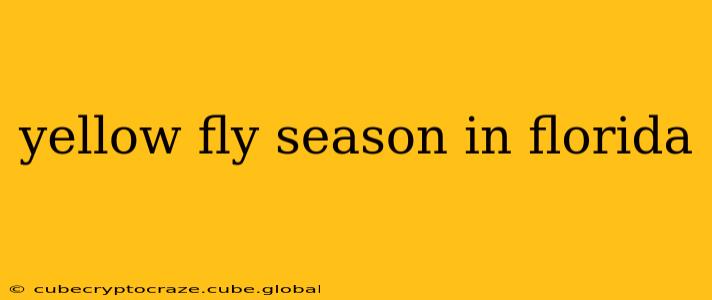Florida's warm climate provides a haven for various insects, and among them, yellow flies are a notorious nuisance, especially during their peak season. These biting flies, scientifically known as Diachlorus ferrugatus, aren't just annoying; their bites can be painful and cause significant irritation. Understanding their life cycle and activity patterns is crucial for minimizing their impact. This guide delves into everything you need to know about yellow fly season in Florida.
When is Yellow Fly Season in Florida?
The yellow fly season typically begins in late spring and extends into early fall, peaking during the summer months (June, July, and August). However, the exact timing and duration can vary based on local weather conditions and geographic location within the state. Warmer, wetter springs may see an earlier start, while cooler, drier summers could result in a shorter season. Coastal areas often experience higher populations due to the availability of breeding grounds near waterways.
Where Do Yellow Flies Live in Florida?
Yellow flies thrive in moist, humid environments close to bodies of water. They are commonly found near:
- Marshes and swamps: These areas provide ideal breeding grounds for their larvae.
- Rivers and streams: The proximity to water is essential for their lifecycle.
- Coastal areas: The humidity and abundant vegetation along the coastline create a favorable habitat.
- Wooded areas near water: These locations offer both shelter and access to breeding sites.
Understanding their preferred habitats allows for better avoidance strategies.
What Attracts Yellow Flies?
Yellow flies are attracted to a variety of factors, including:
- Carbon dioxide: They are drawn to the carbon dioxide we exhale.
- Dark clothing: Dark colors seem to attract them more than lighter ones.
- Movement: Activity tends to draw their attention.
- Sweat: The moisture and salts in sweat can act as an attractant.
How Long Does a Yellow Fly Live?
The lifespan of an adult yellow fly is relatively short, typically ranging from a few weeks to a couple of months. Their life cycle involves an aquatic larval stage, followed by pupation and emergence as adult flies. This relatively short lifespan means that while their presence can be intensely irritating during peak season, the nuisance is typically time-limited.
What are the Best Ways to Prevent Yellow Fly Bites?
Prevention is key when dealing with yellow flies. Here are some effective strategies:
- Wear light-colored clothing: Lighter clothing is less attractive to yellow flies.
- Use insect repellent: Repellents containing DEET, picaridin, or IR3535 are effective. Apply liberally to exposed skin.
- Limit outdoor activities during peak times: Yellow flies are most active during the day, particularly during warmer, humid periods.
- Stay away from their breeding grounds: Avoid marshes, swamps, and other areas known to harbor large yellow fly populations.
- Install screens on windows and doors: This helps prevent them from entering your home.
How to Treat Yellow Fly Bites?
Yellow fly bites can be quite irritating, causing:
- Painful welts: The bites often result in raised, itchy bumps.
- Swelling and redness: Inflammation is common around the bite area.
- Itching: The intense itching can be a significant source of discomfort.
To treat a yellow fly bite, follow these steps:
- Clean the bite area: Wash gently with soap and water.
- Apply a cold compress: This can help reduce swelling and pain.
- Use a topical hydrocortisone cream: This can alleviate itching and inflammation.
- Avoid scratching: Scratching can lead to infection.
- Consider an oral antihistamine: If the itching is severe, an oral antihistamine may provide relief.
In case of allergic reaction (difficulty breathing, swelling of face/throat), seek immediate medical attention.
Are Yellow Flies Dangerous?
While generally not considered dangerous, yellow fly bites can be painful and irritating. For most people, the discomfort is temporary and resolves without complications. However, individuals with allergic reactions may experience more severe symptoms.
This comprehensive guide provides a solid understanding of yellow flies and their impact in Florida. By understanding their behavior and taking preventative measures, you can minimize their impact and enjoy the Florida outdoors more comfortably. Remember, staying informed is the first step towards effective pest management.
